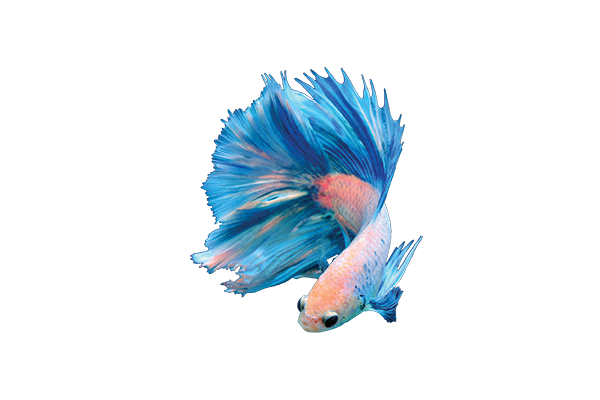Fighting Fish
Sometimes called “Siamese Fighting Fish”, betta belong to the family Osphronemidae, which includes a number of gourami species. They live in shallow pools, small streams, roadside ditches and even rice paddies. The water is sluggish, very warm and often low in dissolved oxygen. As a result, nature has given them the ability to breathe air at the surface using a labyrinth organ, making it possible for them to live in small aquariums without circulation. Their average lifespan is 3 to 4 years.
A Betta’s Natural Habitat
Betta are native to Thailand and other parts of Southeast Asia such as Cambodia, Laos, Vietnam, Malaysia and Indonesia. Their natural habitat is often shaded by overhanging trees and shrubs, as well as aquatic vegetation. There are over 70 recognized species of betta, many of which are now endangered in the wild. The betta fish that we buy as pets are usually Betta splendens or B. imbellis, however, hybrids of these two species as well as B. smaragdina are common in the hobby. There are literally hundreds of different color combinations and fin types available today. While B. splendens and B. imbellis are known to inhabit brackish environments in the wild, one species, Betta mahachaiensis, is found exclusively in alkaline, brackish water in a small area along the coast of the Gulf of Thailand near Bangkok, Thailand.
Water Requirements for Betta Fish
Betta prefer calm water with a pH between 6.8 and 7.5. While betta may seem to tolerate cooler temperatures, they will be inactive and more susceptible to disease therefore it’s best for their overall health to keep the temperature between 76° and 85° F. If the aquarium is kept in rooms below 76°, use an Aqueon Aquatic Flat Heater or Mini Heater with bowls and other small aquarium containers. For aquariums 10 gallons and larger, Aqueon Preset Heaters, Submersible Heaters and Pro Heaters work best.
Betta Fish Housing
Because betta are not very active, they don’t require a lot of space. However, a larger habitat helps with water maintenance. The Aqueon Betta Bowl, LED BettaBow 2.5 and Betta Falls Kits are great choices for getting started on the right foot! While betta do not necessarily need a filter, having one provides them with optimum water quality and lessens the amount of maintenance you have to do. Set the container up at least 48 hours before purchasing your new betta. Decorate the tank with gravel, plants and other items, including some floating cover to make them feel at home. Also remember that betta are jumpers, so keep a secure lid on the tank! In small unfiltered containers, change 1/3 of your betta’s water every 3 to 4 days using an Aqueon Siphon Vacuum Gravel Cleaner. In filtered aquariums, change 25% every 2 to 4 weeks and change the filter cartridge at least once per month. Never change all of your betta’s water at one time! Always treat tap water with Aqueon BettaBowl Plus or Water Conditioner before adding it to the aquarium.
Behavior/Compatibility for Betta Fish
Male betta are highly territorial towards each other and must be kept separately or in a partitioned container. They can be kept with other fish in a larger, peaceful community aquarium. Suitable tankmates include tetras, calm barbs, rasboras, live bearers, corydoras catfish and a number of other non-aggressive fish that are not overly active. Avoid putting them with male gouramis or fin-nippers tiger barbs and active fish like giant danios.
What Do Betta Fish Eat?
Betta eat insects and other invertebrates in the wild and do best on a varied diet. For optimum color and growth, feed a combination of Aqueon Tropical Flakes, Tropical Color Flakes, Betta Food and Betta Treat. In unfiltered containers, feed sparingly, once daily. In filtered aquariums, feed once or twice a day. All food should be consumed in two minutes or less; any remaining food should be removed.
Betta Breeding Level – Intermediate
Betta can be bred in captivity but some extra care is required to raise fry to adults. Betta can be bred with just a few inches of water but do not typically breed easily in a community aquarium due to their solitary nature. Males and females should not be kept together in the same aquarium as the male will often become extremely aggressive towards the female. Male betta will commonly build bubble nests at the water’s surface in their aquarium. Spawning takes place during a “nuptial embrace”, where the male wraps himself around the female, inducing her to release her eggs that the male retrieves and places in the bubble nest. Males care for the nest until the young hatch.
